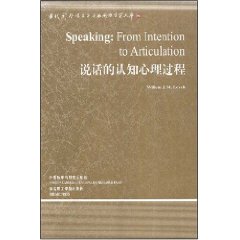基本信息
出版社: 外語教學與研究出版社; 第1版 (2008年8月1日)
 說話的認知心理過程
說話的認知心理過程叢書名: 當代國外語言學與套用語言學文庫
平裝: 566頁
正文語種: 英語
開本: 16
ISBN: 9787560077260, 7560077269
條形碼: 9787560077260
產品尺寸及重量: 22.8 x 15 x 2.4 cm ; 640 g
ASIN: B001GIPIGG 內
容簡介
《說話的認知心理過程(英文版)》出自荷蘭著名心理語言學家Willem. J. M. Levelt之手,堪稱心理語言學的經典之作,也是研究言語產出的必讀書目。作者從心理語言學的角度系統考察了說話的複雜過程,不但對失語症、外語教學、口譯、人工智慧、話語分析等有直接的指導作用,而且由於側重言語產出的過程,還能為語用學、語音學、音系學等帶來新的視角、新的研究課題。
《說話的認知心理過程》行文深入淺出,內容翔實、細節周全,對從事語言學研究的高校師生具有重要的參考價值。
《說話的認知心理過程(英文版)》由外語教學與研究出版社出版。
作者簡介作者:(荷蘭)萊維爾特 (Levelt.J.W.)
目錄reface
Acknowledgments
Author's Notes
Chapter 1 The Speaker as Information Processer
Chapter 2 The Speaker as interlocutor
Chapter 3 The Structure of Messages
Chapter 4 The Generation of Messages
Chapter 5 Surface Structure
Chapter 6 Lexical Entries and Accessing Lemmas
Chapter 7 The Generation of Surface Structure
Chapter 8 Phonetic Plans for Words and Connected Speech
Chapter 9 Generating Phonetic Plans for Words
Chapter 10 Generating Phonetic Plans for Connected Speech
Chapter 11 Articulating
Chapter 12 Self-Monitoring and Self-Repair
Appendix Symbols from the International Phonetic Alphabet, with Examples
Bibliography
Author Index
Subject Index
Talking is one of our dearest occupations. We spend hours a day convers-ing, telling stories, teaching, quarrelingand, of course, speaking toourselves. Speaking is, moreover, one of our most complex cognitive,linguistic, and motor skills. Articulation flows automatically, at a rate ofabout fifteen speech soimds per second, while we are attending only to theideas we want to get across to our interlocutors.
This fascinating human skill has not received the attention it deserveswithin psycholinguistics. Psycholinguistics is the science of human lan-guage production, comprehension, and acquisition, but the main body ofresearch and teaching relates primarily to the latter two topics. Languageproduction is the stepchild of psycholinguistics. Butterworth's (1980c,1983b) excellent two-volume anthology is the only source on the subject;there is no text and no coherently Written handbook.
When the European Science Foundation invited me to lecture on"speaking" at a summer course in psycholinguistics to be held in Brusselsin 1985, I gladly accepted and began writing what I thought would be anintroductory text. A year and a half would suffice, I thought, in view of therather limited psycholinguistic literature on the subject.
My main discovery was that the literature on speaking is gigantic. Butthe majority of it is not to be found in standard psycholingnistic sources.Other disciplines have asked the questions that psycholinguists haveignored. Students of conversational analysis, pragrnatics, discourse se-mantics, artificial intelligence, syntax, phonology, speech communication,and phonetics have contributed myriad theoretical insights and empiricalfindings. The major problem with this huge literature, however, is that itis compartmentalizedhphoneticians ignore phonology, conversationalanalysts ignore discourse semantics and phonetics, students of AI ignorepsycholingnistics, and so on
